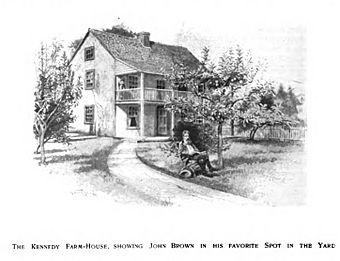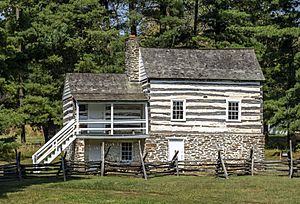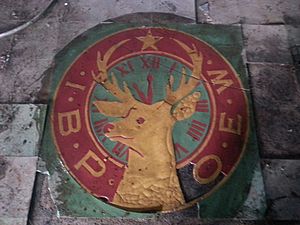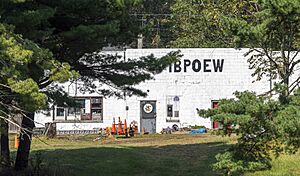Kennedy Farmhouse facts for kids
|
Kennedy Farm
|
|

The Kennedy Farmhouse, sketch published in 1902. John Brown in the chair in the yard.
|
|
| Location | Samples Manor, Maryland |
|---|---|
| Area | 1.77 acres (0.72 ha) |
| Built | c. 1800, 1852 |
| NRHP reference No. | 73000941 |
Quick facts for kids Significant dates |
|
| Added to NRHP | November 7, 1973 |
| Designated NHL | November 7, 1973 |
The Kennedy Farm is a special place in rural southern Washington County, Maryland. It is known as the spot where John Brown, a strong supporter of ending slavery, planned his famous raid. In 1859, he started his attack on Harpers Ferry, Virginia (now West Virginia) from this farm.
The farm is also called the John Brown Raid Headquarters or Kennedy Farmhouse. It is a building made of logs, stone, and brick. It has been carefully fixed up to look just like it did during the time of the raid. Today, a group that works to save historic places owns the farm.
Contents
A Historic Place
The Kennedy Farm is a small piece of land, less than two acres, located a few miles north of Harpers Ferry, West Virginia. It is in a quiet, country part of southern Washington County, Maryland. This land was once part of a much larger farm. Dr. Robert Kennedy bought it in 1852.
Dr. Kennedy took a small log cabin that was already on the property. He placed it on a tall stone foundation, which was about one story high. He also added a wooden section to one side. Then, he covered both parts with a sloped roof. Dr. Kennedy passed away in 1858.
John Brown's Secret Plan
John Brown arrived in Maryland in 1859 and rented the house. For three months, Brown and his helpers lived there. They pretended to be looking for mining opportunities. But secretly, they were planning something big.
More supporters arrived, and weapons were brought to the farm. They were getting ready to attack the federal armory (a place where weapons are stored) at Harpers Ferry. Their goal was to help enslaved people become free.
Life at the Kennedy farmhouse was simple. The men slept on the floor upstairs. Brown's daughter Anne and his daughter-in-law Martha helped with cooking and keeping watch. They slept on mattresses filled with rough material. Wooden boxes of weapons were covered and used as seats. Brown even had to buy a stove because cooking in the fireplace was difficult.
The Raid Begins
On October 16, 1859, the day of the raid, 19 of the 22 people at the farm left to carry out the attack. Three people stayed behind at the farmhouse. They were Owen Brown, Barclay Coppock, and Francis Jackson Meriam. Their job was to guard and manage the weapons.
When it became clear that the raid was not going as planned, all three escaped to the north. Owen went to his brother John Jr.'s house in Ohio.
Right after the raid, the farmhouse was searched. Many of John Brown's letters were found. Also, many copies of his "provisional constitution" were discovered. This was his plan for a new government that would not allow slavery. These findings were widely reported in newspapers. They helped people try to figure out who had given money to support Brown.
The Kennedy Farm is the most important location connected to John Brown's raid, besides the engine house at the arsenal. The engine house was where the raiders held out for less than a day. The Kennedy Farm has been added to the National Register of Historic Places. This means it is recognized as a very important historic site.
After the Raid
Over the next 100 years, the house was owned by many different people. It also changed quite a bit. In 1950, a group called the IBPOEW (Black Elks) bought the property. They wanted to honor John Brown and used it as their National Shrine.
A Place for Gatherings and Music
Before selling the property in 1966, the Elks built several buildings on the farm. At that time, the property was 235 acres. They built a large auditorium, about 50 feet by 124 feet. This hall was used for Elks meetings, with up to three thousand people gathering on holidays like the Fourth of July and Labor Day.
A local Black business owner named John Bishop rented the auditorium on summer weekends. He brought many famous rhythm and blues stars to perform there. These included Ray Charles, Aretha Franklin, James Brown, Marvin Gaye, Little Richard, Chuck Berry, B. B. King, Eartha Kitt, Otis Redding, Etta James, The Coasters, and The Drifters.
Restoring the Farmhouse
When the Kennedy Farm was named a National Historic Landmark in 1974, it was described as a two-and-a-half-story house. It was built using stone, brick, and logs, with a stucco coating on the outside. It had four sections, with a two-level porch along three rooms on the first and second floors. There were two rooms in the attic and a small shed added to the back. Inside, a staircase connected the main rooms. An outside staircase linked the two levels of the porch.
After this, a big project began to restore the house. Money from both public and private sources helped to make the house look just like it did in the 1850s.
See also







